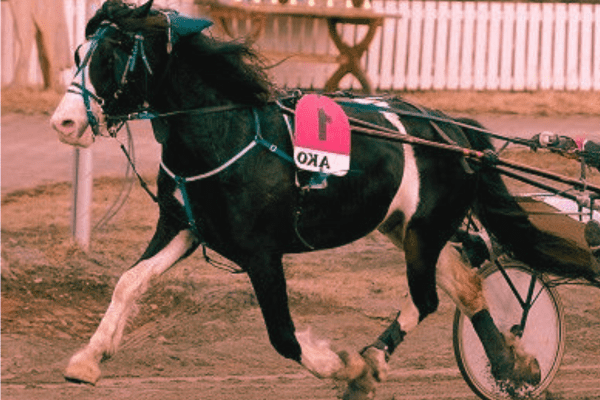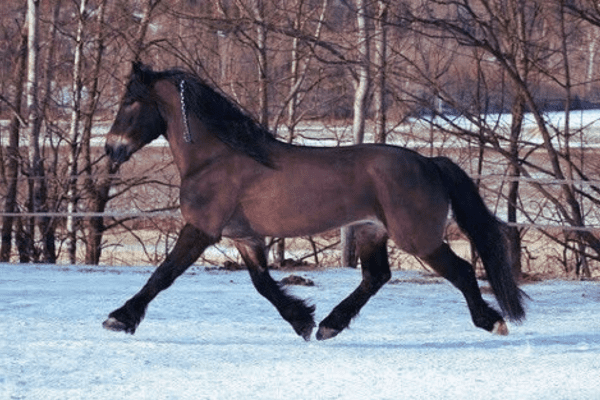The Scandinavian Coldblood Trotter, predominantly nurtured in select Nordic nations, emerges as a distinct horse breed, conceived through the meticulous crossbreeding of native, sturdy coldblooded farm horses with breeds that exhibit greater speed and agility.
This breed’s origins are deeply rooted in its association with two specific and closely linked varieties: the Swedish Coldblood Trotter (Svensk Kallblodstravare) and the Norwegian Coldblood Trotter (Norsk Kaldblodstraver). This lineage underscores a deliberate and strategic breeding approach, aimed at marrying the resilience and power of local breeds with enhanced speed and dexterity, thereby crafting an equine breed of remarkable versatility and robustness, well-suited to the Nordic equestrian landscape.
History:
The Scandinavian Coldblood Trotter horse breed boasts an illustrious past shaped by strategic breeding practices across Norway and Sweden. Here is an in-depth examination of key milestones and challenges associated with this development of this distinguished species:
Development in Local Farm Horses:
This breed traces its lineage back to Norway’s Dolehest and Sweden’s North Swedish Horse, both famous for their robust builds and endurance in Scandinavia’s harsh climates.
Crossbreeding for Improved Traits:
Breeders seeking to improve local breeds with speed and agility initiated crossbreeding programs by incorporating genetics from lighter, faster horse breeds. Their goal was to combine the strength and hardiness of farm horses with speedy horses from lighter breeds for optimal results.
Establish Stud-Books:
Norway recognized the necessity of formal breed standards and records in 1939, followed by Sweden in 1964. These stud-books became invaluable tools for tracking lineage, maintaining standards, and making future breeding decisions.
Crossbreeding of Norwegian and Swedish Types:
After the 1950s, an important change occurred as interbreeding between Norwegian and Swedish types began in earnest. This crucial phase helped define today’s Scandinavian Coldblood Trotters by mixing characteristics from both national strains into one new breed.
Debut as a Single Breed:
Over time, through extensive interbreeding, Norwegian and Swedish variants of dogs have gradually interbred, eventually merging to form what are now commonly considered one breed with distinct features from both countries’ histories.
Current Conservation Status:
Though this breed boasts a rich heritage, its numbers have steadily decreased since 2012. Norway had 1,464 mares and 100 stallions as recently as 2012; by 2019 this had dropped to 764 mares and 64 stallions; Sweden reported 1,380 mares and 180 stallions by comparison.
Due to this decline, concerns have been expressed over its future; consequently, DAD-IS has classified this breed as ‘at endangered.
Conservation Efforts and the Future:
Conservation initiatives aimed at maintaining and revitalizing this breed have been undertaken, including efforts such as sustainable breeding practices, genetic diversity maintenance and increasing awareness about its historical and cultural importance.
Significance to Nordic Equestrian Culture:
The Scandinavian Coldblood Trotter holds a special place in Nordic equestrian culture. Thanks to their versatile strength and agility, these horses have become beloved breeds used for various activities ranging from farming and riding lessons, recreational riding and harness racing.

Characteristics:
The Scandinavian Coldblood Trotter, an impressive horse breed originating in Scandinavian countries, displays distinct traits that set it apart from other horse breeds. Here’s an in-depth breakdown of its distinguishing features.
Stature and Size:
The breed typically exhibits a strong stature, with stallions typically reaching heights of around 154 cm (15.1 hands) at their withers. Breed standards stipulate a minimum height requirement of 148 cm (14.2 hands), providing consistency among individuals while maintaining an impressive presence.
Coat Color Variations:
Bay shades predominate among coat color variants, offering a wealth of variations. Chestnut and black coat colors also appear regularly, and dun and cream genes have been noted in the breed’s genetic pool, yet white and pinto patterns remain absent as per its traditional coloring standards.
Distinctive Head and Facial Features:
The breed’s head features a small square shape accentuated by large nostrils. Not only does this contribute to their distinctive appearance, but it also facilitates breathing more easily during colder climates.
Adaptation to Cold Climates:
Coldblood Trotters have evolved to thrive in Scandinavia’s severe conditions by producing substantial winter hair growth that makes up a blanket-free barrier during colder months. This natural adaptation speaks volumes for their resilience and adaptability in harsh climates.
Comparison with Standardbred:
Comparative to its Standardbred counterpart, Scandinavian Coldblood Trotters tend to be smaller, heavier and more compact in build. While they may not match up speed-wise with its counterpart, they make up for it through strength and endurance.
Geographical Concentration:
Coldblood Trotters, predominantly bred in Norway and Sweden, have deep roots in Nordic equestrian traditions. Although rare outside their native region, this breed remains unique and esteemed within it.

Uses of Scandinavian Coldblood Trotters:
This versatile breed, widely recognized for its adaptability and resilience, serves a multitude of functions in both traditional and contemporary settings. Here’s a breakdown of its various uses.
Harness Racing: One of the primary applications for Scandinavian Coldblood Trotters is harness racing. These horses are well known for their powerful trots and excel in this highly popular Nordic sport, known as harness racing. Their endurance and strength make them great competitors during these races.
Agricultural Work: These horses were extensively employed for farming and agricultural tasks for centuries across rural Scandinavia, particularly due to their robust build and placid temperament which made them suitable for heavy labor such as plowing fields and hauling heavy loads.
Recreational Riding: Recently, this breed has gained considerable attention in recreational riding circles. Their gentle temperament and steady gait make them great choices for leisure activities such as trail riding or therapeutic riding programs suited for riders of all skill levels.
Show and Competition: In addition to racing, Scandinavian Coldblood Trotters participate in many equine shows and competitions. Their striking build and distinctive appearance makes them appealing contestants in show rings at events showcasing traditional Scandinavian horse breeds.
Education and Cultural Preservation: The breed also serves an educational function, helping preserve and promote Scandinavian equestrian culture. They often feature in cultural events and educational programs which focus on sharing its history and significance to local populations.

